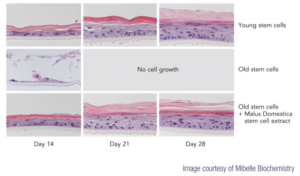You may have heard of one of the growing trends in cosmetic skincare actives – stem cells – but be left wondering: how are they used in cosmetics, and what are they, anyway? This article will take a look at what stem cells are in the body compared to how stem cells are used in cosmetic formulas, as well as why they are so effective and worth exploring in your next formulation developments.
What are stem cells?
In the body, stem cells are undifferentiated cells ready for replication. They may become copies of themselves, or become specific cells needed by different organs or tissues. The epidermis is an organ with continual cell renewal of ideally, 27 days; so epidermal stem cells are essential to help our skin looking rejuvenated and fresh, as well as for repair if we suffer any sort of skin damage.
As we age, the skin’s stem cells become less in number and activity, which results in slower skin cell turnover, uneven skin tone, thinning of the epidermis and devitalised appearance. Together, these activities manifest as sagging skin, fine lines and wrinkles. If we can support the activity of the epidermal skin cells, however, we can improve the function of the epidermal skin cells to reverse these signs of ageing and restore a more youthful appearance.
Hair follicles are subject to the same impact of ageing, and we are now seeing cosmetic actives using stem cell technology to reduce hair thinning, loss and greying by boosting the function of hair stem cells also.
What stem cells are used as cosmetic ingredients?
Cosmetic active ingredients with stem cell efficacy come from plant cell cultures, making them a unique, renewable and sustainable cosmetic ingredient. Certain plant cell cultures have shown clinically proven activity to nurture the reading of epidermal gene functions, to improve the body’s natural stem cell functionality.
Plant stem cell cultures, as used in cosmetic active ingredients, have also shown protection against oxidative stress to delay the rate of ageing and need for replication.

In this image, you can see how the application of plant stem cell cultures in vitro have restored the activity of epidermal cells to a more youthful state, such that the result is practically indistinguishable to healthy young stem cells.
In terms of visible results, this means a thicker epidermal layer, revitalised appearance and more even skin tone – in other words, restoring the skin to a more youthful appearance.
Are stem cells in cosmetics like those used for medical research?
Absolutely not! Stem cells used in medical research are cultivated from human tissue; while the stem cells we use in cosmetic formulas are created through a biotechnology process from selected plant stem cells, which are grown in a pure and sustainable way, to become a plant stem cell culture. They are highly sustainable with proven clinical results both in vitro and in vivo.
Understand the use of stem cells in cosmetic formulas further by watching this video.
Are plant stem cell cultures effective?
Cosmetic actives based on plant stem cell cultures with clinically proven efficacy are incredibly effective if you can get them to the basal layers of the epidermis where they are needed. While it is incredibly difficult for many cosmetic ingredients to travel that far (watch this video for a detailed explanation), you only need a very small amount of plant stem cell culture to reach the target site to get outstanding visible results.
Make sure your cosmetic formula has enhanced delivery ingredients and methods, like in this video, to ensure you get the plant stem cell cultures to where they will work best. Once there you can expect to see:
- advanced visible anti-ageing results with in 28 days; or with certain plant based stem cells, dramatic improvements to hair follicles;
- antioxidant benefits, which protect bodily stem cell longevity and function;
- reversal in signs of ageing such as improvements to skin tone and texture; or for the hair,
Searching for stem cell culture cosmetic actives
There are now multiple suppliers offering a variety of plant stem cell culture-based actives, for general and targeted anti-ageing benefits for both the skin and the hair. Search for the supplier with the right stem cell active for your needs:
- attend in-cosmetics exhibitions and industry events seeking suppliers promoting stem cell actives;
- visit the innovation zone at your nearest in-cosmetics event to see the latest stem cell launches;
- search cosmetic ingredient databases such as UL Prospector using ‘stem cells’ as a search term.
Remember to check efficacy data carefully to make sure you are selecting the stem cell active with the desired results for your cosmetic formulation and also consider the plant source used and how this can add to your sustainability and marketing stories.
Remember also to keep your marketing claims based on visible anti-ageing (or hair densifying) results to comply with cosmetic regulations and show the before/after results to really demonstrate the potential of these amazing cosmetic ingredients.
Happy formulating!
Enjoyed this article? Get more by subscribing to our newsletter!
Feeling inspired to see ingredients and trends in action?
Then why not visit one of the in-cosmetics events around the world?

